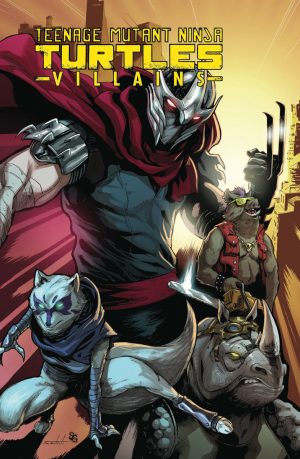I’ve always found it monumentally difficult to review short story/one-shot collections, or rather I’ve found it difficult to review them fairly as, due to their extreme diversity in creative voices and talents, you’re always likely to find at least one really good segment and one really bad segment, leading to most collections ending up as a middling review if taken on aggregate. Often it is the theme that allows collections to stand out, more so than a single one of the varied creative voices in a collection, due to its ability to draw out the best in these different creators. For example: a writing prompt such as ‘love’ would probably draw out more boring, indistinct stories than would a prompt such as ‘the rogues gallery of four mutated turtle ninjas living in the sewers of New York’, which is itself a strong premise.
Regardless, TMNT Villains is another one-shot collection that continues the habit of its strong entries and its weaker entries coming together to create something of a blur. However, the strength of the ‘Turtles’ set-up and the generally above-average talents of the people involved in the collection does create more good than bad and for that I am grateful.
The two stand-out pieces of the collection are ‘Alopex’ and ‘Bebop and Rocksteady’, for two completely different reasons. Alopex stands out from continuity-keeper stories (such as the collection’s ‘Shredder’ and ‘Old Hob’ stories) by having a very deep connection between art and story which leads me to believe that the artist and writer, Sophie Lynch and Bryan Campbell respectively, were either very good friends or at least dedicated to the act of communication.
Sophie Lynch, acting as both artist and at least partial colorist, uses colors to place extra emphasis on allowing the images to explain unambiguously what the subtext of the events and dialogue is trying to subtly communicate. Alopex speaks through her teeth, calmly, about betrayal and cowardice while her violent, visceral actions and movements are surrounded by warm, manic colors. No narrator is needed to tell the audience that Alopex is seething inside, overcome by a rage that she is only barely managing to keep from boiling over. This story is one of the finer examples of  dialogue and visuals working together to create a compelling story that speaks what it needs to with a perfect blend of visuals and writing.
dialogue and visuals working together to create a compelling story that speaks what it needs to with a perfect blend of visuals and writing.
The ‘Bebop and Rocksteady’ entry is appealing for a much simpler reason, that reason being that in the right hands, Bebop and Rocksteady are natural scene stealers and scriptwriter Dustin Weaver knows exactly how to use them. The best writers use Bebop and Rocksteady not as simple comic-relief but as a much needed source of relationship-levity. The difference here is that while the Turtles themselves are fun-loving and prone to jokes, Bebop and Rocksteady, their wisecracks and their relationship lighten the mood for the Turtle’s entire rogues gallery, meaning that their job is to allow characters like Shredder or Karai to be as incensed and brooding as the writer wants to make them while still giving the story enough color and lightness-of-heart to make it still feel like a ‘Turtles’ story. Bebop and Rocksteady are at their best when bumbling just a little and enjoying each other’s company. I can’t give TMNT Villain’s ‘Bebop and Rocksteady’ a higher review than saying that it accomplishes this dynamic perfectly and I highly recommend reading, if nothing else, this extremely enjoyable entry.
Even the low points of this collection are skillfully written and drawn, the Shredder story paints a unique and colorful picture of a classic villain, one that often feels incongruous with the Shredder we’ve known for so long, but, again, unique nonetheless. The stories for Krang, Baxter Stockman and newcomer villain Hun are all entertaining enough, though they don’t stick out in any meaningful way besides the inherit oddities of writing stories for the Turtles world which are entertaining in themselves.
The low-points of the collection manifest in Old Hob and Karai’s entries, which already have the disadvantage of being placed directly in the timeline of the ongoing comic series but do very little to combat this problem. It feels like no coincidence that both of these comics are origin stories (actually, most of these comics are origin stories or at least allude to the origins of these characters as villains) in that it’s the most efficient use of time for these characters, as in their origins need to be explained eventually, might as well use that time here.
Old Hob, while he is a welcome addition to the Turtle’s timeline, simply talks too much. His origin story is a flashback, narrated by Old Hob himself, recounting a series of events that are uncharacteristically standard and boilerplate for the TMNT universe. The writing is perfectly acceptable, there’s simply too much of it. Karai’s story on the other hand is a legitimate bore, split into two parts, the first being perhaps the most standard origin story that ‘Turtles’ has ever had, the second being a fight sequence with brainwashed and arrogant Leonardo, leading to an unexciting fight sequence between two extremely unpleasant characters. I’d recommend skipping it entirely.
I’m giving Teenage Mutant Ninja Turtles Villains a 4/5, leaning positive due to the strength of its better entries standing out more than the slight tedium of its lesser entries. I would personally recommend buying the digital issues of the characters you’re interested in, but as far as collections go, this is a pretty solid entry playing with some fun and unique concepts. This reviewer gives Turtles Villains a resounding “sure, why not?”
[su_box title="Score: 4/5" style="glass" box_color="#8955ab" radius="6"]
[/su_box]
